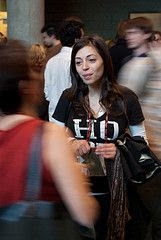
In the summer of 2002, Naomi Natale had an experience that would transform her from a photography student in picturesque Albuquerque, N.Mex., into what she calls “a little crazy woman with big, crazy ideas.” That summer, Natale read a fundraising letter from Kenya’s Sisters of Mary Immaculate, about the millions of African children who have been orphaned by AIDS, civil war, and poverty. It inspired Natale to travel to Kenya with her camera to document the local orphan crisis and help the nonprofit raise money to help. But Natale didn’t expect the summer project to change her life. “I went there trying to help people fundraise for thousands of orphans and came back with individual faces stuck in my mind and real-life stories,” Natale told TEDxMidatlantic conferees in Baltimore last month.
One of those stories was especially unforgettable, Natale said, about two artistically gifted orphan brothers living in the slums of Nairobi, who sculpted toy airplanes and trucks from scrap metal that they found on the streets. Natale never met the boys; by the time she had heard about them, they had disappeared from the streets and were presumed to be dead by those who knew them. The youngest boy was eight years old. “To this day,” Natale says, “I continuously wonder about the tremendous potential that is disappearing along with the lives and the futures of children in crises like these.”
Inspired, Natale, in the fall of 2006, created a public art project that would help to raise money for the orphans. She invited 1,000 artists, school groups and people in her family and friends networks to make cradles out of scrap materials. Each cradle, she explained, would symbolize the lost potential of children in crisis. “If we can see enough potential in a piece of scrap to make a cradle, why can’t we see enough potential in our orphans to act?” Natale asked as part of her invitation.
She didn’t expect much of a response: each invitee, she explained, would be expected to raise $100 from others to both make the cradle and donate to the Firelight Foundation, which helps build small orphanages in Africa.
But Natale underestimated the appeal: The Cradle Project generated interest from across the country. More than 555 artists sent in cradles, which were shown at a public art installation in an abandoned warehouse in Albuquerque in 2007 attended by more than 5,000 visitors. In all, more than $90,000 was raised for the Firelight Foundation through sponsorships, an auction of the cradles and sales of a book on the cradle project.
And now, Natale, a 2010 TED Fellow, is thinking even bigger. Her new One Million Bones project, aims to raise awareness of genocide around the world. Once again, she is inviting artists and citizens to participate – but this time is asking 1 million people to create fabricated human bones, each symbolizing someone killed or displaced due to genocide.
Her new goal: to collect these “bones” and display them, this summer or fall, on the National Mall in Washington. Each bone will be sponsored by an artist, who will make each bone and also donate $5 to the project per bone, thereby generating $5 million that would, in turn, go to partner organizations working to help genocide victims around the globe. For $15, people who wish to participate but who don’t want to make a bone, Natale says, can have bones made for them by public artists supporting the project.
Sound far-fetched? Natale is the first to say her idea is bold and audacious. But she is passionate and has already generated growing interest among public artists around the country. “Most of us will never view a mass grave and most of us will never understand what a pile of human bones looks or sounds or feels like,” she says. In 1994, President Clinton’s national security advisor, Anthony Lake, said that if the U.S. government was to support effective action to stop the genocide, “then the American public needed to make it clear that’s what they want. Lake encouraged human rights advocates to ‘make more noise’ and thereby direct the U.S. government’s response to the crisis,” Natale told TEDxMidatlantic conferees in November. “I want us to make noise today in Sudan, in the Democratic Republic of Congo, in Burma and in other places around the world where people are being denied the right to exist. Governments are murdering their people and our governments are responsible by international law to intervene but we as their citizens must tangibly pressure them to do so. By installing 1 million bones on the national mall in Washington, I am demanding the people and the journalists and the politicians to pay attention. If they do, it will create a noise impossible to ignore.”
Public art, she says, is a powerful tool for social action, but it’s a form that is not being used enough. “People need to understand their role in a movement if they’re going to consider participating and they need to be able to see that they can take ownership in that movement, and have their actions followed by reactions,” she says. Large-scale public art installations can help people to see the impact of their actions. “Letters, phone calls and emails to decision-makers can play an extremely important role,” Natale says, “but not enough people use these forms of protest or dissent because they doubt that their individual correspondence makes a difference. But that attitude leads to inaction, and then nothing changes and people give up hope.”
Public art like One Million Bones, says Natale, can break that cycle of apathy. “All I know is that I’m not okay with genocide happening on our watch,” she says. “As individuals, we can use our voices and action to tell our governments and the international community to solve these problem, using the power of a symbol and the importance of those who know the stories behind those symbols to keep telling them.”




























No comments:
Post a Comment